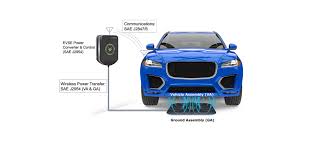
SAE International announced the publishing of two new documents to enable electric vehicles (EVs) a safe and efficient method for transferring power from a charging station to the vehicle.
* SAE J2954™ Standard: “Wireless Power Transfer & Alignment for Light Duty Vehicles”
* SAE J2847/6™ Recommended Practice: “Communication for Wireless Power Transfer between Light-Duty Plug-in Electric Vehicles and Wireless EV Charging Stations”
“The publication of these two groundbreaking SAE Wireless Charging and Communications documents, SAE J2954 and SAE J2847/6, are the result of countless hours of work from SAE taskforces and industry to offer confidence in the safety and interoperability of these technologies as we approach commercialization,” said Jack Pokrzywa, Director of Global Ground Vehicle Standards, SAE International. “We are grateful for all of the significant contributions from technology providers, automotive industry manufacturers, government agencies and regulatory bodies that enabled the successful establishment of the standard.”
SAE J2954™ Standard
SAE J2954 establishes the first standard for wireless power transfer for both electric vehicle and Electric Vehicle Supply Equipment (EVSE). This enables light duty electric vehicles and infrastructure to safely charge up to 11kW, over an air gap of 10 inches (250 mm) achieving up to 94 percent efficiency.
Under SAE International leadership, a number of companies created a Cooperative Research Project (CRP) with industry funding for both bench and vehicle testing. The standard has been validated for safety, interoperability and performance based on years of actual bench testing and vehicle interoperable data taken from the SAE WPT CRP Industry Group, American Association of Medical Instrumentation, United States Food and Drug Administration (FDA) and with the United States Department of Energy.
“The SAE J2954 standard is a game-changer by giving a ‘cook-book’ specification for developing both the vehicle and charging infrastructure wireless power transfer, as one-system, compatible to 11 kW,” stated Jesse Schneider, Chair of the SAE J2954 Taskforce. “The SAE J2954 alignment technology gives additional parking assistance, even allowing for vehicles park and charge themselves autonomously. The SAE task force coordinated with industry and international standards organizations to ensure global WPT harmonization. Publishing SAE J2954 is a major step forward in wireless charging commercialization for EVs.”
SAE continues its WPT standardization work with higher power levels also for heavy duty vehicles with the future SAE J2954/2.
SAE J2847/6™ Recommended Practice
In September 2020, SAE published a revised J2847/6, “Communication for Wireless Power Transfer between Light-Duty Plug-in Electric Vehicles and Wireless EV Charging Stations.” which leveraged the work of the SAE J2954 Alignment and Controls Sub-Team and extended a JSON-based message set (protocol) originally developed to bench test wireless energy transfer interoperability between unmatched GA and VA systems. Also added were messages sufficient to indicate proper coil alignment, initialize the sub-systems for wireless charging, ramp-up to full power, perform active wireless power transfer, and terminate the WPT session.
“SAE J2847/6 is a wireless communications document utilizing WiFi, IEEE 802.11n, designed specifically with the SAE J2954 standard and facilitates the automatic wireless charging experience while allowing for continuous optimization of the WPT system.” stated Ky Sealy, co-lead of SAE J2847/6.
For more information on these standards, please visit:
* SAE J2954: https://www.sae.org/standards/content/j2954_202010/
* SAE J2847/6: https://www.sae.org/standards/content/j2847/6_202009/
About SAE International
SAE International is a global association committed to advancing mobility knowledge and solutions for the benefit of humanity. By engaging nearly 200,000 engineers, technical experts and volunteers, we connect and educate mobility professionals to enable safe, clean, and accessible mobility solutions. We act on two priorities: encouraging a lifetime of learning for mobility engineering professionals and setting the standards for industry engineering. We strive for a better world through the work of our philanthropic SAE Foundation, including award-winning programs like A World In Motion® and the Collegiate Design Series™. More at www.sae.org













More Stories
Flexible Magna Manufacturing Solutions: The Key to Success in the Automotive Industry
DuPont technology helps improve EV battery durability and performance
Automotive Industries (AI) Newsletter October 2024